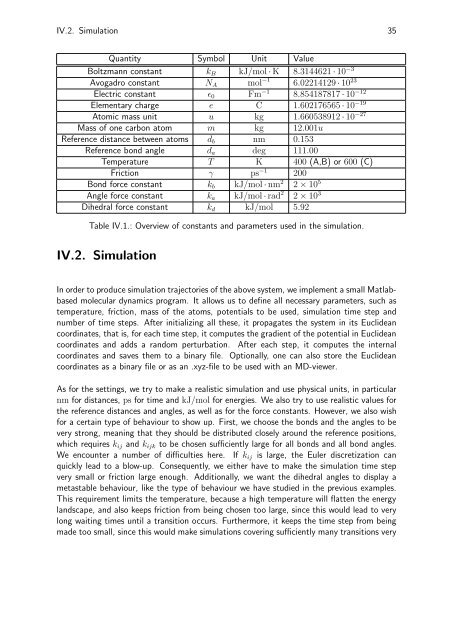Variational Principles in Conformation Dynamics - FU Berlin, FB MI
Variational Principles in Conformation Dynamics - FU Berlin, FB MI
Variational Principles in Conformation Dynamics - FU Berlin, FB MI
- No tags were found...
You also want an ePaper? Increase the reach of your titles
YUMPU automatically turns print PDFs into web optimized ePapers that Google loves.
IV.2. Simulation 35Quantity Symbol Unit ValueBoltzmann constant k B kJ/mol · K 8.3144621 · 10 −3Avogadro constant N A mol −1 6.02214129 · 10 23Electric constant 0 Fm −1 8.854187817 · 10 −12Elementary charge e C 1.602176565 · 10 −19Atomic mass unit u kg 1.660538912 · 10 −27Mass of one carbon atom m kg 12.001uReference distance between atoms d b nm 0.153Reference bond angle d a deg 111.00Temperature T K 400 (A,B) or 600 (C)Friction γ ps −1 200Bond force constant k b kJ/mol · nm 2 2 × 10 5Angle force constant k a kJ/mol · rad 2 2 × 10 3Dihedral force constant k d kJ/mol 5.92Table IV.1.: Overview of constants and parameters used <strong>in</strong> the simulation.IV.2. SimulationIn order to produce simulation trajectories of the above system, we implement a small Matlabbasedmolecular dynamics program. It allows us to def<strong>in</strong>e all necessary parameters, such astemperature, friction, mass of the atoms, potentials to be used, simulation time step andnumber of time steps. After <strong>in</strong>itializ<strong>in</strong>g all these, it propagates the system <strong>in</strong> its Euclideancoord<strong>in</strong>ates, that is, for each time step, it computes the gradient of the potential <strong>in</strong> Euclideancoord<strong>in</strong>ates and adds a random perturbation. After each step, it computes the <strong>in</strong>ternalcoord<strong>in</strong>ates and saves them to a b<strong>in</strong>ary file. Optionally, one can also store the Euclideancoord<strong>in</strong>ates as a b<strong>in</strong>ary file or as an .xyz-file to be used with an MD-viewer.As for the sett<strong>in</strong>gs, we try to make a realistic simulation and use physical units, <strong>in</strong> particularnm for distances, ps for time and kJ/mol for energies. We also try to use realistic values forthe reference distances and angles, as well as for the force constants. However, we also wishfor a certa<strong>in</strong> type of behaviour to show up. First, we choose the bonds and the angles to bevery strong, mean<strong>in</strong>g that they should be distributed closely around the reference positions,which requires k ij and k ijk to be chosen sufficiently large for all bonds and all bond angles.We encounter a number of difficulties here. If k ij is large, the Euler discretization canquickly lead to a blow-up. Consequently, we either have to make the simulation time stepvery small or friction large enough. Additionally, we want the dihedral angles to display ametastable behaviour, like the type of behaviour we have studied <strong>in</strong> the previous examples.This requirement limits the temperature, because a high temperature will flatten the energylandscape, and also keeps friction from be<strong>in</strong>g chosen too large, s<strong>in</strong>ce this would lead to verylong wait<strong>in</strong>g times until a transition occurs. Furthermore, it keeps the time step from be<strong>in</strong>gmade too small, s<strong>in</strong>ce this would make simulations cover<strong>in</strong>g sufficiently many transitions very









